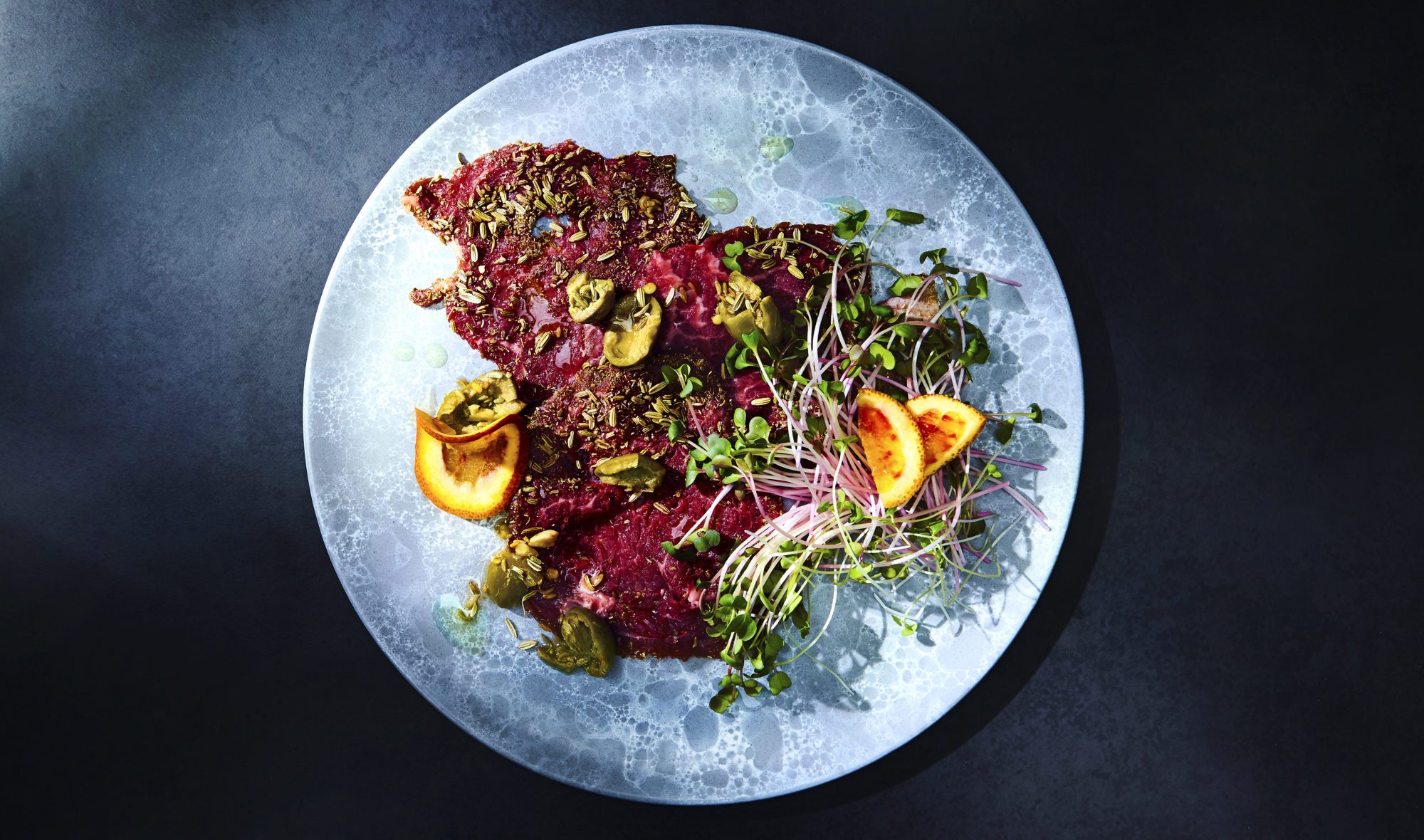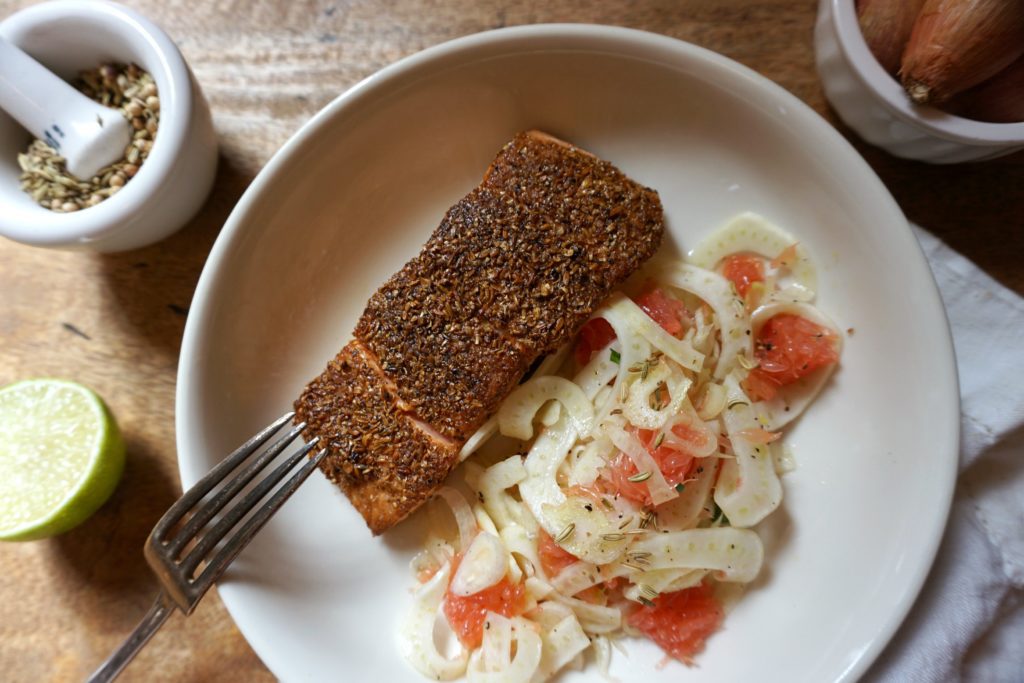
💰 This week only: Save $250 USD on the PN Nutrition Certification!

Fennel seeds, small and pale green, are a sweet and highly aromatic spice. This hearty plant is in the same family as carrots, dill, and parsley, and grows wildly and stubbornly in many parts of the globe. In Australia and the United States, fennel is so invasive it is considered to be a weed. Fennel has a unique, sweet, herbaceous, and licorice-y taste that is very similar to anise. Like most spices, fennel is not a significant source of nutrition in the amounts typically consumed, although it is used in herbal medicine to treat digestive upset. The versatile presence of fennel can be found in anything from Italian sausages to toothpaste.
Fennel, as a spice, is a small pale green seed. In this compact kernel, major flavor is found.
Much like the vegetable bulb from which fennel flowers and seeds sprout, fennel seeds have a distinctive, licorice-y taste. Around the globe, you will find pops of this sweet spice in interesting places: in traditionally made Italian sausages; sugar-coated as an edible breath-freshener in India; in the alcoholic mixture absinthe; and even as a flavoring agent in toothpastes.
Fennel is in the carrot family (which also includes parsley and dill) and grows from tiny yellow flowers on thin stems that radiate from a central stem. When the seeds are ready to harvest, the stems will dry out and turn from green to yellowish-brown. At this stage, the seeds will easily fall off the plant with a little agitation to encourage them.
Fennel grows wild in many parts around the world, particularly in North America, Northern Europe, Asia, and Australia. Fennel is such a robust (bordering on invasive) crop that it is considered a weed in Australia and the United States.
Fennel seeds are small, narrow, and pointy-ended, with ridges running lengthwise. They are a muted brownish-green and are highly aromatic. Their odor and flavor is sweet and herbaceous, with strong similarities with anise and licorice.
Typically fennel is sold as whole seeds, but it may be found as a powder as well.
Fennel, like most spices, is not a significant source of nutrition in the amounts typically consumed.
However, in herbal medicine, fennel is used to treat digestive distress such as gas, bloating, heartburn, poor appetite, and nausea.
Fennel can be found at most good quality grocery stores, health food stores, bulk food stores, and spice shops.
Ideally (and this follows the advice of most culinary experts), buy your fennel in seed form. Use the seeds whole or grind them as needed in small batches. Seeds are easily ground using either a mortar and pestle or a clean coffee mill. While you can purchase fennel already ground, it loses potency quickly in this form.
However you are purchasing it, shop at stores with high turnover, and in the case of bulk food stores, covered bins.
Whether in its ground or seed form, good quality fennel should be highly aromatic and sweet smelling. Avoid products with a weak aroma, or those that smell musty.
Keep fennel seeds or powder in a sealed container at room temperature, ideally away from heat and light, such as a closed cupboard or drawer away from the oven.
Ground fennel is particularly prone to losing potency over time. After grinding, it only has a shelf life of a few months. After this time, it is still perfectly good to eat, but it will have lost much of its flavor. Whole fennel seeds however, will stay fresh and potent for about a year.
Fennel, as a spice, is ready to use as-is and is a delicious addition to fish or poultry dishes, cooked whole grains, pasta sauces, and many other recipes.

Fennel appears in all its glory in this dish: Toasted fennel and coriander seeds perfume savory salmon filets and fresh fennel bulb pairs with a medley of citrus in a refreshing side salad.
Prep Time: 30 minutes Cook Time: 10 minutes Yield: 2 servings
For the Salad:
Add sliced fennel bulb, grapefruit segments, and shallots to a bowl.
Whisk together lime juice, honey, and olive oil.
Pour lime juice mixture over fennel bulb mixture and toss to combine. Season with salt and fresh pepper according to taste preferences. Sprinkle sparingly with fennel seeds, and serve alongside salmon.
For the Salmon:
First, toast the seeds: Place fennel seeds and coriander seeds in a dry skillet over medium-high heat. Toast, stirring frequently until seeds are fragrant and golden brown at the edges, about 3 minutes.
Then, grind the seeds: Place toasted fennel and coriander seeds in a pestle and mortar or spice grinder, along with sea salt and pepper. Process until a coarse spice blend is achieved. Pour this mixture onto a plate and spread it in a relatively even layer.
Next, prepare the salmon filets: Preheat the oven to 375 degrees Fahrenheit. Drizzle about a teaspoon of olive oil over each filet, and then dredge the top of each filet in the spice mixture. Heat a generous amount of olive oil in a non-stick oven-safe skillet over medium-high heat, and wait until it is hot enough that a flick of water sizzles upon contact. Once heated, place salmon filets, spice-dredged side down onto the skillet and sear for about 2 minutes, until a golden brown crust forms. Then, transfer the skillet to the preheated oven, and cook for an additional 6-8 minutes. Salmon is done when it has lost its translucency and flakes easily with a fork.
Plate the salmon filets with the fennel citrus salad, drizzle with additional olive oil, and season with additional salt and pepper, if desired. Serve, and enjoy.
Precision Nutrition’s Encyclopedia of Food expands every single month as we highlight new foods and showcase beautiful food photography. If you’d like to stay up to date, simply click this link. From there, we’ll send you a FREE copy of our recipe book. We’ll also let you know when new and delicious foods are added to the site.
Fennel seeds, small and pale green, are a sweet and highly aromatic spice. This hearty plant is in the same family as carrots, dill, and parsley, and grows wildly and stubbornly in many parts of the globe. In Australia and the United States, fennel is so invasive it is considered to be a weed. Fennel has a unique, sweet, herbaceous, and licorice-y taste that is very similar to anise. Like most spices, fennel is not a significant source of nutrition in the amounts typically consumed, although it is used in herbal medicine to treat digestive upset. The versatile presence of fennel can be found in anything from Italian sausages to toothpaste.